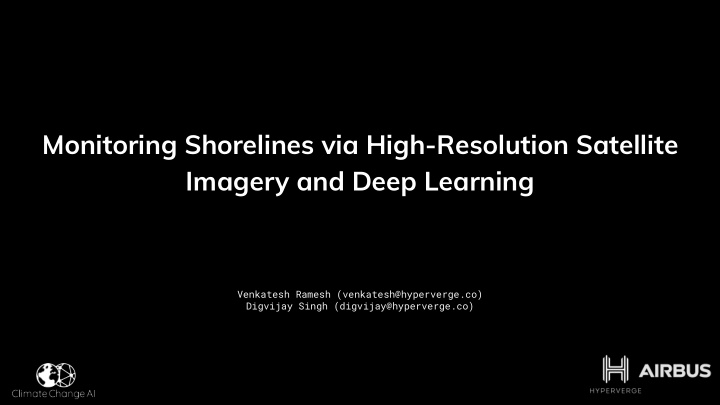



Monitoring Shorelines via High-Resolution Satellite Imagery and Deep Learning Venkatesh Ramesh (venkatesh@hyperverge.co) Digvijay Singh (digvijay@hyperverge.co)
Motivation : Impact on Human Lives Sea level rise has had a severe impact on the coastal population, with currently around 110 million people placed below the local high tide line and 250 million on lands below projected annual flood levels. 2 HYPERVERGE PROPRIETARY INFORMATION Source: World Meteorological Organisation / Flickr
Motivation : Geographical Impact Fig1. Regions of interest where coastal impact is measured and mapped in terms of beach erosion (red) and beach accretion (green). The horizontal plot at the bottom and vertical plot to the right indicates the phenomena occurrence on longitudinal and latitudinal scale, respectively [1] . 3 HYPERVERGE PROPRIETARY INFORMATION [1] Luijendijk et al. The State of the World’s Beaches. Sci Rep 2018
Newer and more accurate DEM estimate across the globe paints an alarming picture Fig2 . Relative increase in estimated exposure of population on vulnerable lands when compared between the older SRTM model and the newer CoastalDEM [2] modeling. Newer projections place 110M people below their local high-tide line and estimate 190M by 2100. 4 HYPERVERGE PROPRIETARY INFORMATION [2] Kulp et al. New elevation data triples estimates of global vulnerability to sea-level rise and coastal flooding. Nat Commun 2019
Dataset Meeting the need for a dataset using high-resolution imagery for ● mapping shorelines across the world [3] . Locations Covered - Chennai (India), Nubel Island (Denmark), ● Coolangatta Bay (Australia), Freeport Texas(USA) and Byron Bay (Australia). The total length of the shoreline in the current dataset is 60km ● with more being added. Consists of three classes marked as segments: ● Land (in yellow) ○ Sea (in blue) ○ Water-runup, a new class between the wet sand line and ○ water line (in purple) [3] High-Resolution satellite imagery used is provided in support to this project by Airbus. 5 HYPERVERGE PROPRIETARY INFORMATION
Conclusion and Future Work Comparative analysis using the state-of-art Deep Learning semantic segmentation models and an array of ● hyper-optimization strategies. Augment the data with more regions, ensure high standards with quality checks and release to public domain. ● Model evaluation on test data and releasing codebase and baseline model weights. ● Demonstrate tracking of shoreline across multiple years for high-impact/high-population regions on a larger ● time-frame, and create a case for using Machine Learning based automatic triggers 6 HYPERVERGE PROPRIETARY INFORMATION
THANK YOU! HYPERVERGE PROPRIETARY INFORMATION
Recommend
More recommend